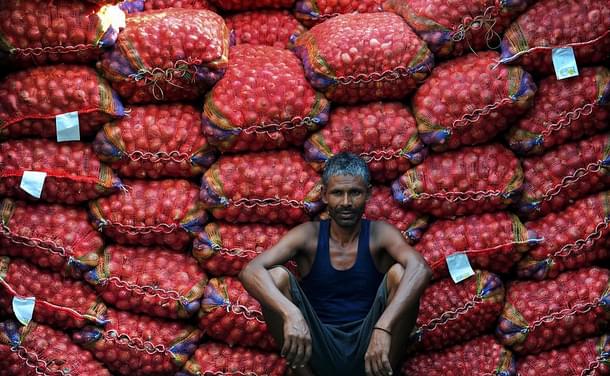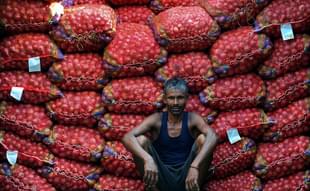Politics
Daily Wagers Top Suicide Numbers; But Have Farmers’ Suicides Risen Or Fallen?
Seetha
Jan 04, 2017, 02:10 PM | Updated 02:10 PM IST
Save & read from anywhere!
Bookmark stories for easy access on any device or the Swarajya app.


There’s been much noise about farmers’ suicides, with the release of Accidental Deaths and Suicides in India 2015 (ADSI-2015) report by the National Crime Records Bureau (NCRB). The report shows an increase in suicides in the farming sector, with the figure put at 12,602 in 2015, up 1.95 per cent over 2014.
One statistic has escaped attention, however. Suicides by daily wage earners numbered 23,799 in 2015, a 51.2 per cent jump over 15,735 suicides in 2014. For the first time ever, daily wage earners have dislodged housewives as the largest single group by profession in suicide statistics. Housewives held that dubious honour in every annual ADSI report.
The number of suicides by housewives stood at 22,293 in 2015, up 10 per cent from 20,148 in 2014, though it is lower than the 2013 figure of 22,742.
Tragic as farmers’ suicides are, the question needs to be asked; why is there no outrage over the much larger number of suicides by daily wage earners?
But since farmers’ suicides dominate the discourse, let’s parse the data related to that. Have they increased or decreased over time?
ADSI-2015 puts the number of suicides in the farming sector in 2015 (January-December) at 12,602, up from 12,360 in 2014 and 11,772 in 2013. After 2009, when suicides by farmers numbered 17,368, there had been a steady decline till 2013.
Now this is certainly cause for concern.
But there’s a catch. From 2014, the annual ADSI reports introduced a new category – agricultural labourers. So, of the 12,602 suicides in the farming sector in 2015, only 8,007 are of farmers; 4,595 are of agricultural labourers.
But, yes, there has been an increase over 2014 – farmers’ suicides that year numbered 5,650. Suicides by agricultural labourers declined from 6,710 in 2014 to 4,595 in 2015.
Going by this, then, the number of farmers’ suicides has seen a steep drop since 2013. That seems disproportionate to the noise over the issue.
Now here’s another catch. ADSI reports before 2014 only gave a consolidated figure for ‘self-employed in farming/agriculture’ (emphasis added). Can agricultural labourers be categorised under self-employed, since they will be paid a wage? If not, were pre-2014 figures about farmers alone? In that case, farmers’ suicides have declined drastically, even though 2014 and 2015 were drought years (farmers’ suicides spiked in 2004 (18,241) and 2009 (17,368), both drought years).
If the figures for earlier years included agricultural labourers, then there is no way of knowing if farmers’ suicides have increased or decreased. NCRB needs to clarify this; this is important for a sober, rational debate on farmers’ suicides.
A question that is certain to be asked is, why should the farmers/labourers categorisation be important? After all, agricultural labourers may also be committing suicide because of agricultural stress.
So, let’s look at the reasons for suicides.
In the case of farmers/cultivators, agricultural stress is clearly the main cause. Bankruptcy or indebtedness and farming-related issues were the top two reasons in both 2014 and 2015. In 2014, bankruptcy accounted for 20 per cent of farmers’ suicides; this rose to 38.7 per cent in 2015. Farming crises were responsible for 11.7 per cent of farmers’ suicides in 2014; it rose to 19.5 per cent in 2015.
And what about agricultural labourers? Family problems were responsible for 40 per cent of suicides in 2015 (the 2014 report does not give this break-up), followed by illness (19 per cent) and other causes (13.4 per cent). Indebtedness accounted for 5.5 per cent of suicides, and comes fifth after drug abuse/alcoholism (6.8 per cent).
ADSI 2015 underlines the seriousness of the indebtedness problem in rural areas. The number of suicides caused by it soared 2.6 times in just one year – from 1,163 in 2014 to 3,097 in 2015.
The report also busts a popular notion that it is the informal lending channels (money-lenders, etc) that are more usurious and ruthless in their dealings. The report shows that of the 3,097 persons who committed suicide due to bankruptcy in 2015, 79.8 per cent had taken loans from banks, financial institutions and registered micro-finance organisations. Only 9.7 per cent had borrowed from money-lenders and non-financial institutions; another 10 per cent had borrowed from both. (ADSI 2014 disaggregated bankruptcy on different parameters – crop loan, farm equipment loan and non-agricultural loan – which do not figure in ADSI 2015.)
Incidentally, this is true of agricultural labourers as well. Sixty per cent of the 255 labourers who committed suicide due to indebtedness had taken loans from financial institutions and only 40 per cent from money-lenders/non-financial institutions.
Which farmers face more stress and are more prone to committing suicide?
ADSI reports of 2014 and 2015 show that suicide rates were higher among the small and marginal farmers; together they accounted for 72 per cent of suicides in both years. Small farmers (owning 1-2 hectares) accounted for 44.5 per cent of suicides in 2014 and 45.2 per cent in 2015. Marginal farmers (less than 1 hectare) accounted for 27.9 per cent of suicides in 2014 and 27.4 per cent in 2015.
Suicides by medium farmers (2 to 10 hectares) went up a mite from 25.2 per cent to 25.4 per cent between 2014 and 2015. In the case of large farmers (10 hectares and above), suicides fell from 2.3 per cent to 1.9 per cent.
The fact that small and marginal farmers account for the bulk of suicides contradicts the view held by some agricultural experts that this group is less risk-averse and supplements its farm income by taking up casual labour. According to this view, it is the medium farmer, who takes risks and gets into commercial farming and is not able to cope with stress, who is more prone to suicide.
For too long has the debate around farmers’ suicides been polemical and not based on adequate information, with activists and whichever party is in power insisting that this was because of faulty government policies, and politicians in power airily – even callously – dismissing these concerns. The last two ADSI reports give details of causes (with inter-state variations) and the debate should now be more sober and fact-driven. Both activists and politicians need to realise this.
And can someone please spare a thought for daily wage earners, please?
Seetha is a senior journalist and author





